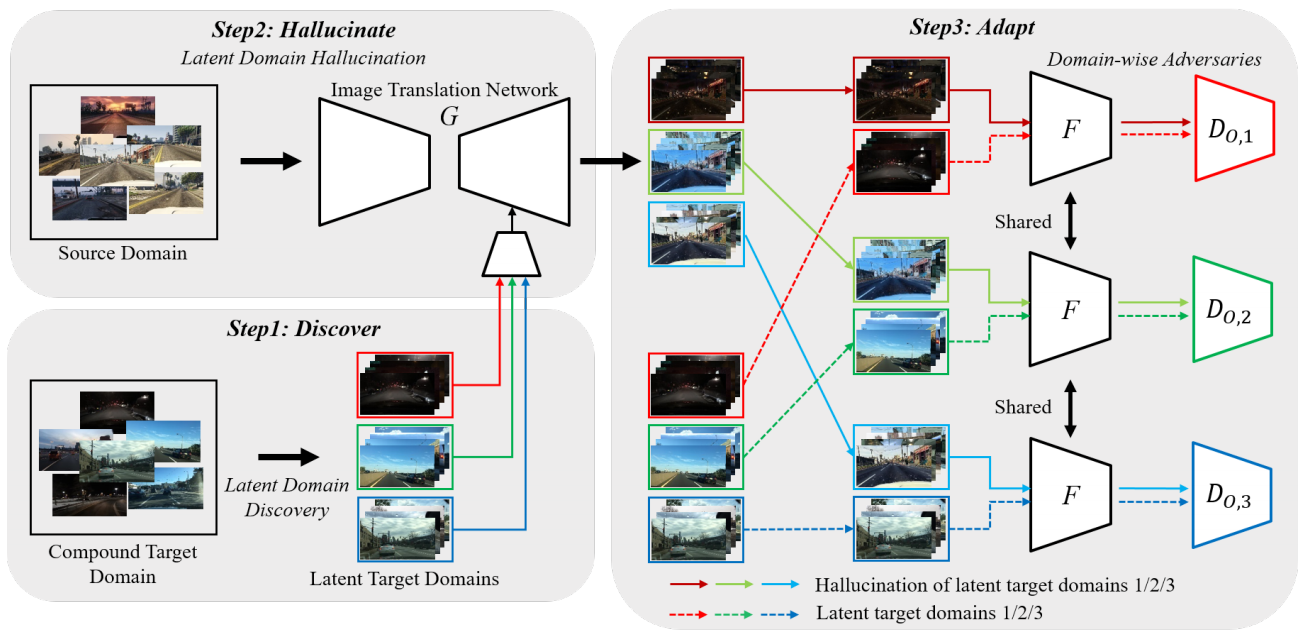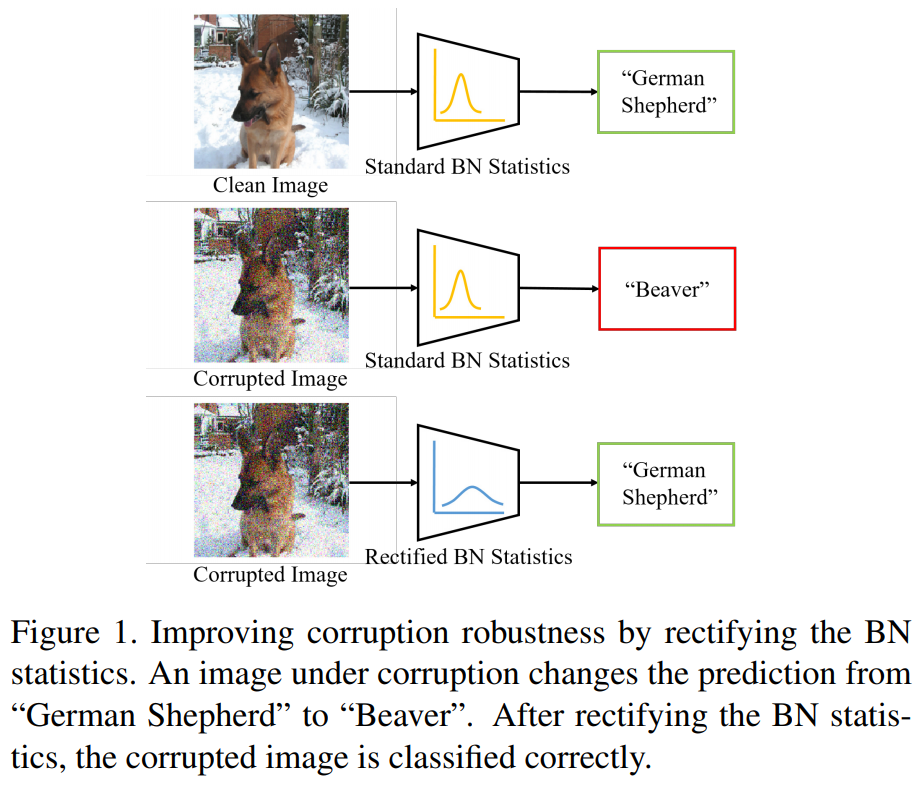Conference/Journal, Year: AAAI 2021
The booming interest in adversarial attacks stems from a misalignment between human vision and a deep neural network (DNN), i.e. a human imperceptible perturbation fools the DNN. Moreover, a single perturbation, often called universal adversarial perturbation (UAP), can be generated to fool the DNN for most images. A similar misalignment phenomenon has recently also been observed in the deep steganography task, where a decoder network can retrieve a secret image back from a slightly perturbed cover image. We attempt explaining the success of both in a unified manner from the Fourier perspective. We perform task-specific and joint analysis and reveal that (a) frequency is a key factor that influences their performance based on the proposed entropy metric for quantifying the frequency distribution; (b) their success can be attributed to a DNN being highly sensitive to high-frequency content. We also perform feature layer analysis for providing deep insight on model generalization and robustness. Additionally, we propose two new variants of universal perturbations: (1) Universal Secret Adversarial Perturbation (USAP) that simultaneously achieves attack and hiding; (2) high-pass UAP (HP-UAP) that is less visible to the human eye.

Conference/Journal, Year: AAAI 2021
In most of computer vision applications, motion blur is regarded as an undesirable artifact. However, it has been shown that motion blur in an image may have practical interests in fundamental computer vision problems. In this work, we propose a novel framework to estimate optical flow from a single motion-blurred image in an end-to-end manner. We design our network with transformer networks to learn globally and locally varying motions from encoded features of a motion-blurred input, and decode left and right frame features without explicit frame supervision. A flow estimator network is then used to estimate optical flow from the decoded features in a coarse-to-fine manner. We qualitatively and quantitatively evaluate our model through a large set of experiments on synthetic and real motion-blur datasets. We also provide in-depth analysis of our model in connection with related approaches to highlight the effectiveness and favorability of our approach. Furthermore, we showcase the applicability of the flow estimated by our method on deblurring and moving object segmentation tasks.
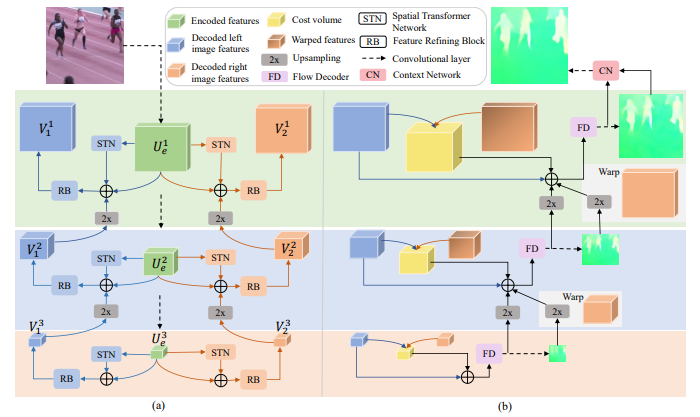
Conference/Journal, Year: AAAI 2021
Abrupt motion of camera or objects in a scene result in a blurry video, and therefore recovering high quality video requires two types of enhancements: visual enhancement and temporal upsampling. A broad range of research attempted to recover clean frames from blurred image sequences or temporally upsample frames by interpolation, yet there are very limited studies handling both problems jointly. In this work, we present a novel framework for deblurring, interpolating and extrapolating sharp frames from a motion-blurred video in an end-to-end manner. We design our framework by first learning the pixel-level motion that caused the blur from the given inputs via optical flow estimation and then predict multiple clean frames by warping the decoded features with the estimated flows. To ensure temporal coherence across predicted frames and address potential temporal ambiguity, we propose a simple, yet effective flow-based rule. The effectiveness and favorability of our approach are highlighted through extensive qualitative and quantitative evaluations on motion-blurred datasets from high speed videos.
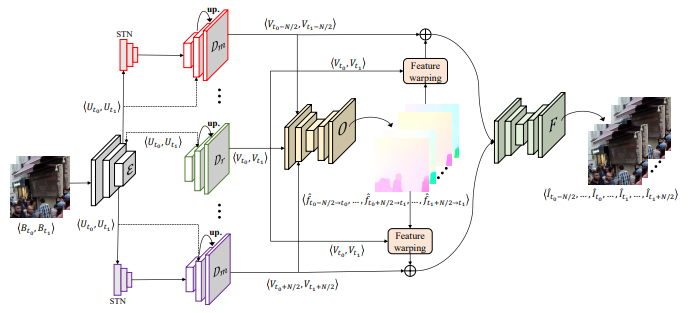
Conference/Journal, Year: AAAI 2021
We present an end-to-end joint training framework that explicitly models 6-DoF motion of multiple dynamic objects, ego-motion and depth in a monocular camera setup without supervision. Our technical contributions are three-fold. First, we highlight the fundamental difference between inverse and forward projection while modeling the individual motion of each rigid object, and propose a geometrically correct projection pipeline using a neural forward projection module. Second, we design a unified instance-aware photometric and geometric consistency loss that holistically imposes self-supervisory signals for every background and object region. Lastly, we introduce a general-purpose auto annotation scheme using any off-the-shelf instance segmentation and optical flow models to produce video instance segmentation maps that will be utilized as input to our training pipeline. These proposed elements are validated in a detailed ablation study. Through extensive experiments conducted on the KITTI and Cityscapes dataset, our framework is shown to outperform the state-of-the-art depth and motion estimation methods. Our code, dataset, and models are available at https://github.com/SeokjuLee/Insta-DM.
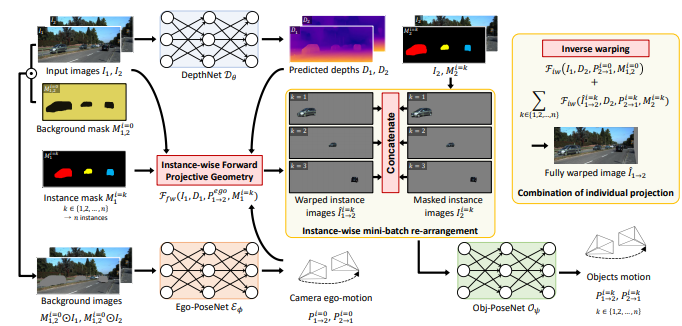
Conference/Journal, Year: WACV 2021
ResNet or DenseNet? Nowadays, most deep learning based approaches are implemented with seminal backbone networks, among them the two arguably most famous ones are ResNet and DenseNet. Despite their competitive performance and overwhelming popularity, inherent drawbacks exist for both of them. For ResNet, the identity shortcut that stabilizes training might limit its representation capacity, and DenseNet mitigates it with multi-layer feature concatenation. However, the dense concatenation causes a new problem of requiring high GPU memory and more training time. Partially due to this, it is not a trivial choice between ResNet and DenseNet. This paper provides a unified perspective of dense summation to analyze them, which facilitates a better understanding of their core difference. We further propose dense weighted normalized shortcuts as a solution to the dilemma between them. Our proposed dense shortcut inherits the design philosophy of simple design in ResNet and DenseNet. On several benchmark datasets, the experimental results show that the proposed DSNet achieves significantly better results than ResNet, and achieves comparable performance as DenseNet but requiring fewer computation resources.
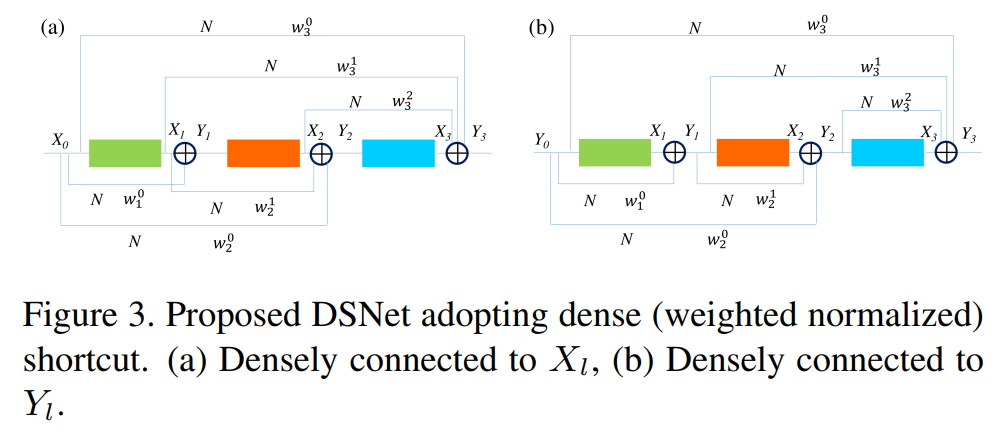
Conference/Journal, Year: WACV 2021
Pursuing a more coherent scene understanding towards real-time vision applications, single-stage instance segmentation has recently gained popularity, achieving a simpler and more efficient design than its two-stage counterparts. Besides, its global mask representation often leads to superior accuracy to the two-stage Mask R-CNN which has been dominant thus far. Despite the promising advances in single-stage methods, finer delineation of instance boundaries still remains unexcavated. Indeed, boundary information provides a strong shape representation that can operate in synergy with the fully-convolutional mask features of the single-stage segmenter. In this work, we propose Boundary Basis based Instance Segmentation(B2Inst) to learn a global boundary representation that can complement existing global-mask-based methods that are often lacking highfrequency details. Besides, we devise a unified quality measure of both mask and boundary and introduce a network block that learns to score the per-instance predictions of itself. When applied to the strongest baselines in singlestage instance segmentation, our B2Inst leads to consistent improvements and accurately parse out the instance boundaries in a scene. Regardless of being single-stage or twostage frameworks, we outperform the existing state-of-theart methods on the COCO dataset with the same ResNet-50 and ResNet-101 backbones.

Conference/Journal, Year: WACV 2021
The performance of DNNs trained on clean images has been shown to decrease when the test images have common corruptions. In this work, we interpret corruption robustness as a domain shift and propose to rectify batch normalization (BN) statistics for improving model robustness. This is motivated by perceiving the shift from the clean domain to the corruption domain as a style shift that is represented by the BN statistics. We find that simply estimating and adapting the BN statistics on a few (32 for instance) representation samples, without retraining the model, improves the corruption robustness by a large margin on several benchmark datasets with a wide range of model architectures. For example, on ImageNet-C, statistics adaptation improves the top1 accuracy of ResNet50 from 39.2% to 48.7%. Moreover, we find that this technique can further improve state-of-the-art robust models from 58.1% to 63.3%.
Conference/Journal, Year: WACV 2021
Videos have recently become an omnipresent form of media, gathering much attention from industry as well as academia. In the video enhancement field, video frame interpolation is a long-studied topic that has dramatically improved due to the advancement of deep convolutional neural networks (CNN). However, conventional approaches utilizing two successive frames often exhibit ghosting or tearing artifacts for moving objects. We argue that this phenomenon comes from the lack of reliable information provided only by two frames. With this motivation, we propose a frame interpolation method by utilizing tridirectional information obtained from three input frames. Information extracted from triplet frames allows our model to learn rich and reliable inter-frame motion representations, including subtle nonlinear movement, which can be easily trained via any video frames in a self-supervised manner. We demonstrate that our method generalizes well to high-resolution content by evaluating on FHD resolution, and illustrates our approach’s effectiveness via comparison to state-of-theart methods on challenging video content.

Conference/Journal, Year: NeurIPS 2020
Neural networks have been shown effective in deep steganography for hiding a full image in another. However, the reason for its success remains not fully clear. Under the existing cover (C) dependent deep hiding (DDH) pipeline, it is challenging to analyze how the secret (S) image is encoded since the encoded message cannot be analyzed independently. We propose a novel universal deep hiding (UDH) meta-architecture to disentangle the encoding of S from C. We perform extensive analysis and demonstrate that the success of deep steganography can be attributed to a frequency discrepancy between C and the encoded secret image. Despite S being hidden in a cover-agnostic manner, strikingly, UDH achieves a performance comparable to the existing DDH. Beyond hiding one image, we push the limits of deep steganography. Exploiting its property of being universal, we propose universal watermarking as a timely solution to address the concern of the exponentially increasing number of images and videos. UDH is robust to a pixel intensity shift on the container image, which makes it suitable for challenging application of light field messaging (LFM). Our work is the first to demonstrate the success of (DNN-based) hiding a full image for watermarking and LFM.
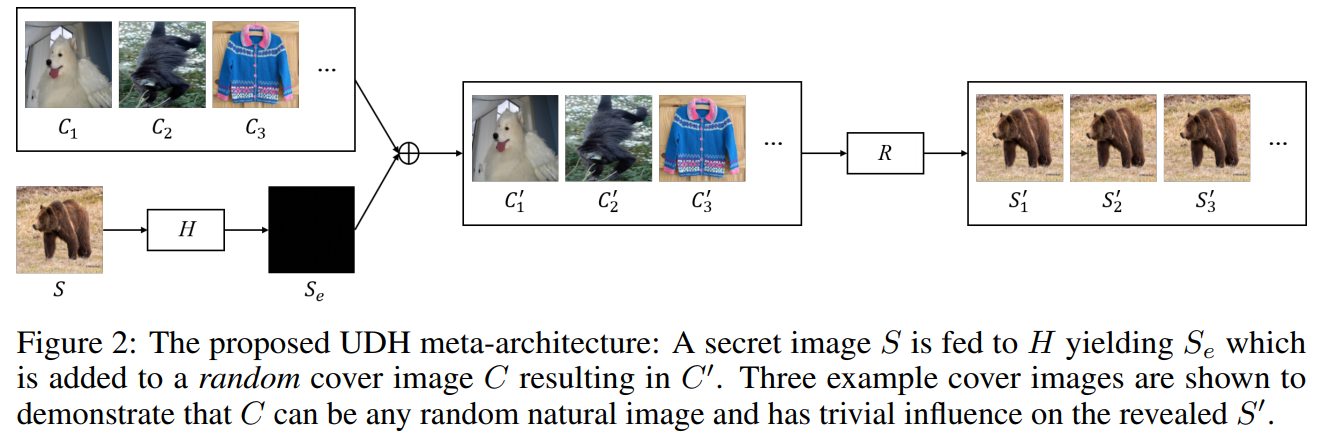
Conference/Journal, Year: NeurIPS 2020
Unsupervised domain adaptation (UDA) for semantic segmentation has been attracting attention recently, as it could be beneficial for various label-scarce real-world scenarios (e.g., robot control, autonomous driving, medical imaging, etc.). Despite the significant progress in this field, current works mainly focus on a single-source single-target setting, which cannot handle more practical settings of multiple targets or even unseen targets. In this paper, we investigate open compound domain adaptation (OCDA), which deals with mixed and novel situations at the same time, for semantic segmentation. We present a novel framework based on three main design principles: discover, hallucinate, and adapt. The scheme first clusters compound target data based on style, discovering multiple latent domains (discover). Then, it hallucinates multiple latent target domains in source by using image-translation (hallucinate). This step ensures the latent domains in the source and the target to be paired. Finally, target-to-source alignment is learned separately between domains (adapt). In high-level, our solution replaces a hard OCDA problem with much easier multiple UDA problems. We evaluate our solution on standard benchmark GTA5 to C-driving, and achieved new state-of-the-art results.
